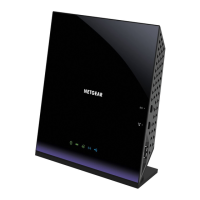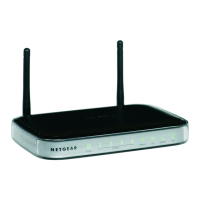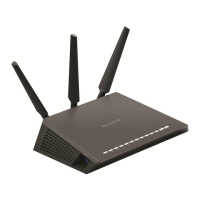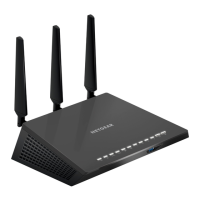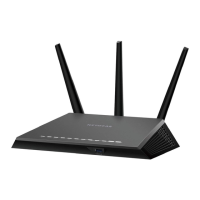(Continued)
DescriptionField
Security Options
This information applies to the 2.4 GHz WiFi network.
If you change the WiFi security, select one of the following WiFi security options for the modem router’s WiFi
network:
• None. An open WiFi network that does not provide any security. Any WiFi device can join the network. We
recommend that you do not use an open WiFi network.
• WEP. Wired Equivalent Privacy (WEP) security is a legacy authentication and data encryption mode that is
superseded by WPA-PSK and WPA2-PSK. The WEP option displays only if you select Up to 54 Mbps from
the Mode menu. For information about configuring WEP, see Configure WEP Legacy WiFi Security on page
92.
• WPA2-PSK [AES]. This option is the default setting.This type of security enables WiFi devices that support
WPA2 to join the modem router’s 2.4 GHz WiFi network. If you did not change the passphrase, the default
passphrase displays.The default passphrase is printed on the product label (see Bottom Panel Product Label
on page 13). WPA2 provides a secure connection but some older WiFi devices do not detect WPA2 and
support only WPA. If your network includes such older devices, select WPA-PSK [TKIP] + WPA2-PSK [AES]
security.
If you change the passphrase, in the Passphrase field, enter a phrase of 8 to 63 characters.To join the
modem router’s WiFi network, a user must enter this passphrase.
• WPA-PSK [TKIP] + WPA2-PSK [AES]. This type of security enables WiFi devices that support either WPA
or WPA2 to join the modem router’s 2.4 GHz WiFi network. However, WPA-PSK [TKIP] is less secure than
WPA2-PSK [AES] and limits the speed of WiFi devices to 54 Mbps.
To use this type of security, in the Passphrase field, enter a phrase of 8 to 63 characters.To join the modem
router’s WiFi network, a user must enter this passphrase.
• WPA/WPA2 Enterprise. This type of security requires that your WiFi network can access a RADIUS server.
For information about configuring WPA/WPA2 Enterprise, see Configure WPA/WPA2 Enterprise WiFi Security
on page 91.
Wireless Network (5GHz a/n/ac)
By default, the modem router broadcasts its SSID so that WiFi stations can detect the
WiFi name (SSID) in their scanned network lists.To turn off the SSID broadcast, clear
the Enable SSID Broadcast check box.Turning off the SSID broadcast provides
additional WiFi security, but users must know the SSID to be able to join the WiFi network
of the modem router.
Enable SSID Broadcast
If you want to stream high-definition video, select this check box.When this option is
selected, the modem router uses video reliability algorithms to reduce jitter and packet
loss during video presentations. If you do not stream videos, leave this check box cleared.
Enable Video Network
The SSID is the WiFi network name. If you did not change the SSID, the default SSID
displays.The default SSID is also printed on the product label (see Bottom Panel Product
Label on page 13).
If you change the SSID, enter a 32-character (maximum), case-sensitive
name in this field.
Note
Name (SSID)
Manage the Basic WiFi Network Settings
88
AC1200 WiFi VDSL/ADSL Modem Router Model D6220

